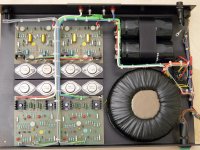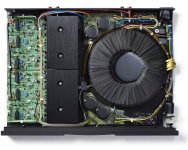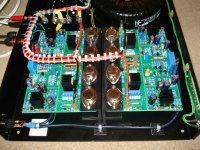I have been looking at the sizes of heatsink used in domestic commercial 80-100W per channel output amplifiers to find a rule of thumb/tried and tested guide to sizing a heatsink and to consider enclosure space, venting or not and saw this Naim 250 with the covers off.
Two friends owned these amplifiers back in the late 70's and the base panel ran very hot when the volume was past 12 o'clock for a while but I never saw inside one.
The power transistors for the amplifier and regulation modules appear to have no more than a piece of U channel alloy that looks to be 4mm in thickness. The channel pieces attached to what I presume is box pan folded steel of a gauge commonly used for small enclosures.
What does anybody know about the heat dissapation in this amplifier? I googled Naim 250 overheating and there are some results but not so many as I would expect.
Two friends owned these amplifiers back in the late 70's and the base panel ran very hot when the volume was past 12 o'clock for a while but I never saw inside one.
The power transistors for the amplifier and regulation modules appear to have no more than a piece of U channel alloy that looks to be 4mm in thickness. The channel pieces attached to what I presume is box pan folded steel of a gauge commonly used for small enclosures.
What does anybody know about the heat dissapation in this amplifier? I googled Naim 250 overheating and there are some results but not so many as I would expect.
Attachments
This amplifier clearly isn't designed to be operated at higher power Levels for a prolonged time.
Btw, I'm somewhat astonished to see other power devices than BDY56's in there?
Best regards!
Btw, I'm somewhat astonished to see other power devices than BDY56's in there?
Best regards!
I agree, I looked at the newer offering from Naim to see if there was an improvement in heat dispersion materials and there is but not as much as I thought there might be.
2015 and the Naim 250 DR has this as heat management, I am very surprised.
2015 and the Naim 250 DR has this as heat management, I am very surprised.
Attachments
This other device appears to dissipate the heat through the lid also. Has there been no thermal compound in between?
Best regards!
Best regards!
I cannot tell but I have been looking for images taken from different angles to see if those channel pieces are thermally bonded just to the enclosure base and it looks like they are.
I am still surprised, these are not budget products. I bought a Quad 405-2 in the same year my friends bought Naim 250's and I recall the Naim being considerably more expensive but the heatsinks! Radiating heat from the base and the base being steel?
I am still surprised, these are not budget products. I bought a Quad 405-2 in the same year my friends bought Naim 250's and I recall the Naim being considerably more expensive but the heatsinks! Radiating heat from the base and the base being steel?
Yes, steel is inferior to aluminium in terms of thermal conductivity. As I said above, don't run it at high power levels for a prolonged time.
Best regards!
Best regards!
The radiator transfers heat to the aluminum sheet housing. HA009H transistors are pressed to the radiator through a ceramic heat-conducting gasket.
Усилитель мощности Naim NAP 250 DR | журнал SalonAV
https://soundex.ru/forum/index.php?/topic/35364-naim-изнутри/
Усилитель мощности Naim NAP 250 DR | журнал SalonAV
https://soundex.ru/forum/index.php?/topic/35364-naim-изнутри/
Last edited:
Ah, so the 250 DR has an aluminium base. It still seems contra to good practice, the base radiates heat both ways which means recycling the heat back through the components. It all obviously works or Naim would not be in business but it does not look like good practice.
Another friend owned two Crimson monoblock amplifiers and had to hang the heatsink over the edge of the shelf it sat on. That one I did get to see inside as we decided to have a look at what could be done. The thermal bridges (bent, not extruded angle alu) did not contact the heatsink very well so we constructed two from extruded angle and lapped them to the heatsink. It was an improvement, not drastically so but it sufficed.
I want to size two heatsinks for monoblock amplifiers that use 2 MJ15003 and 2 BD244CG each and having ran one up with just the thermal bridge that is roughly the same mass as the U channel ones on the Naim 250 and it gets too hot very quickly when driven hard as you might expect.
The original 1976 Naim 250 I am certain employed a steel enclosure and the transfer from the U channel thermal bridges cannot have been ideal to say the least.
Another friend owned two Crimson monoblock amplifiers and had to hang the heatsink over the edge of the shelf it sat on. That one I did get to see inside as we decided to have a look at what could be done. The thermal bridges (bent, not extruded angle alu) did not contact the heatsink very well so we constructed two from extruded angle and lapped them to the heatsink. It was an improvement, not drastically so but it sufficed.
I want to size two heatsinks for monoblock amplifiers that use 2 MJ15003 and 2 BD244CG each and having ran one up with just the thermal bridge that is roughly the same mass as the U channel ones on the Naim 250 and it gets too hot very quickly when driven hard as you might expect.
The original 1976 Naim 250 I am certain employed a steel enclosure and the transfer from the U channel thermal bridges cannot have been ideal to say the least.
The 250 shown in the OP is from the "chrome bumper" series of amplifier models of the 1980s.The image shows only the tray assembly which slides into a heavy wall, rectangular hollow section aluminium extrusion. That shell forms the outer side, top and bottom of the case and the amplifier with it's linear regulated power supplies, is still fine at full, 80W/channel 8R power with music program.
The quiescent current settings of the quasi-complementary design are also quite modest and little heat is noticeable at idle or in normal domestic use.
As a power oscillator running at its maximum power continuously though, I think many of us would certainly have our doubts but what idiot would use an expensive, high quality amplifier for that purpose. If there is problem, it's when pushing it hard in very warm climates and weather but there is plenty of evidence that they still work fine in home use.
The quiescent current settings of the quasi-complementary design are also quite modest and little heat is noticeable at idle or in normal domestic use.
As a power oscillator running at its maximum power continuously though, I think many of us would certainly have our doubts but what idiot would use an expensive, high quality amplifier for that purpose. If there is problem, it's when pushing it hard in very warm climates and weather but there is plenty of evidence that they still work fine in home use.
- Home
- Amplifiers
- Solid State
- The heatsinks in a Naim 250? What?



